Table 2.
Summary of alternative medicinal compounds and extracts reported to affect proliferation, viability, and/or motility of glioblastoma and malignant brain tumor cells.
| Name | Plant Source | Compound | Chemical Structure | Targets | Treatments | Effects | Cell lines | References |
|---|---|---|---|---|---|---|---|---|
| Avishan-e-Shirazi |
Zataria multiflora (thyme-like plant) |
Thymol | Apoptosis; DNA fragmentation | Zataria extract (25–200 µg/ml) + ionizing radiation (3Gy and 6 Gy) | Inhibit cell proliferation; radiosensitize cells; increase apoptosis | A172 | (Aghamohammadi et al., 2015) | |
| Angelic root/female ginseng |
Angelica sinensis (dong quai) |
Phytosterols, polysaccharides, flavanoids | Apoptosis; proliferation; cell cycle | Chloroform extracts (IC50 = 3–47 µg/mL) | Induce apoptosis; arrest cell cycle at G0–G1; activate procaspase 9 & 3; decrease levels of phosphorylated Rb proteins; decrease tumor growth, | DBTRG-05MG, RG2 rat GBM cells, G5T/VGH GBM, GBM 8401, GBM8901 cells, | Tsai et al. (2005) | |
| Berberine |
Berberis vulgaris (barbary fruit); Hydrastis canadensis (goldenseal); B. aquifolium (Oregon grape); Coptis chinensis (goldthread); Radix scutellariae (skullcap) |
Isoquinoline alkaloid |
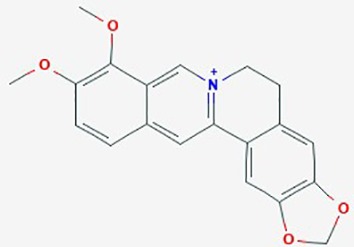
|
1. Cell-cycle; apoptosis 2. EGFR-MEK-ERK signaling; proliferation, |
1. Berberine (50 – 200 µg/ml) 2. Berberine (0–150 µM), TMZ (0–320 µM) |
1. Decrease cell viability (dose dependent); increase ROS & Ca2+; induce ER stress; in increase ratio Bax/Bcl-2 proteins; activate caspase-9 and -3 and cleavage of PARP 2. reduce EGFR; inhibit RAF-MEK-ERL signaling; induce senescence; IC50 6-fold lower than TMZ |
U87, U251, U118, T98G | 1.(Eom et al., 2008) 2. (Liu et al., 2015) |
| Betulinic Acid |
Betula alba (White-barked birch) |
Pentacyclic triterpenoid |
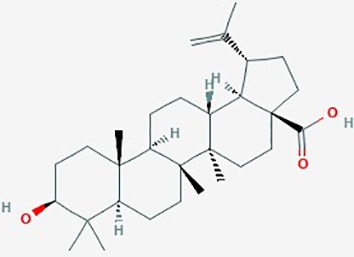
|
1. Apoptosis; BAX and Bcl-2 family of proteins; caspase-PARP cascade 2. NF-Kb; apoptosis 3. apoptosis 4. apoptosis |
1. Betulinic acid (0–250 µM ( 2. Betulinic acid (0–10 µM) 3. Betulinic acid (0–8 µg/ml) + TRAIL (0–10 ng/ml) 4. Betulinic acid (1–100 µg/ml), effective concentrat'n in vitro & in vivo ranged 2–17 µg/ml |
1. increase BAX and Bcl-2 proteins, formation of ROS; apoptosis, EC50 20 µM) 2. activate NF-kB (dose dependent); promote Bet A induced apoptosis, 3. increase cleavage of caspase-8 and Bid by combined betulinic acid and TRAIL; increase apoptosis 4. Bet A induced apoptosis (dose and time dependent); proteolytic degradation of caspase -8, -3 and PARP |
LN229, U273,A172, U118MG, U138MG, U251MG, U343, U373, SK14, SK17, SK19, SK22, SK49, SK51, SK55, SK60 |
1. (Wick et al., 1999) 2.(Kasperczyk et al., 2005); 3. (Fulda et al., 2004) 4. (Fulda et al., 1999) |
| Bittersweet |
Celastrus orbiculatus (Oriental bittersweet) |
Terpenoids |
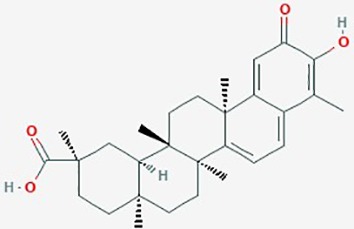
|
Cytoskeleton, N-cadherin, vimentin, MMP-2, MMP-9, E-cadherin genes; | Inhibit migration and invasion (dose dependent); reduce N-cadherin, vimentin, MMP-2 and MMP-9 expression; increase E-cadherin expression; inhibit actin assembly | U87; U251 | (Gu et al., 2016) | |
| Brazilin | Caesalpinia sappan (Sappan wood) | Red dye |
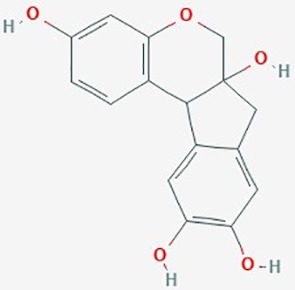
|
Cell cycle, caspase-3 and caspase-7; PARP | Brazilin (0–40 µM) | Decrease proliferation; apoptosis; cell cycle arrest at sub-G1 phase; decrease expression of caspase-3 and caspase-7; increase expression of PARP | U87 | (Lee et al., 2013) |
| Cannabinoids | Cannabis sativa | 11-nor-D9-Tetrahydro-cannabinol-9-carboxylic acid (THC) |
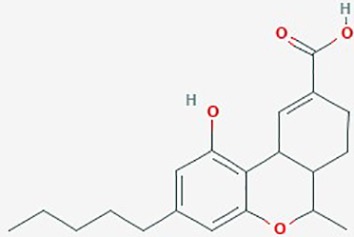
|
1. Cell cycle, apoptosis, ERK; Bcl family 2. cell proliferation, apoptosis |
1. THC (2 µM); 2. THC (2.5– 3.3 µM) + Cannabidiol (0.6–1.2µM) |
1. 9-THC inhibit proliferation; increase apoptosis 2. induce ROS; down regulate phosphorylated ERK; combined THC and Cannabidiol synergistically inhibited cell proliferation |
SG126, U87 MG, U251, SF188, U373 MG, U87 |
1. (Mc Allister et al., 2005); 2. (Marcu et al., 2010) |
| Chokeberry | Aronia melanocarpa | Flavonoids/anthocyanins | Apoptosis, MMP-2, 14, 16 and 17 | Extract (0– 600 µg/ml), effective at >200 µg/ml | Crosses BBB; induce necrosis; downregulate MMP-2, 14, 16 and 17 mRNA levels | U373 | (Thani et al., 2012) | |
| Crude extracts from ginger and Rhazya | Zingiber officinale (ginger); Rhazya stricta (evergreen shrub in Saudi Arabia) | Flavonoid/alkaloids | Apoptosis, Bax, Bcl-2, caspase-3 and -9, and PARP-1; NF-Kβ | Crude Rhazya extracts (0–200 µg/ml); Crude ginger extracts (0–200 µg/ml); or combined (0–50 µg/ml) |
Suppress proliferation and colony formation; combined agents induce apoptosis; increase Bax : Bcl-2 ratio; enhance activities of caspase-3 and -9, and PARP-1 cleavage; downregulate NF-Kβ | U251 | (Elkady et al., 2014) | |
| Cucurbitacin B | Trichosanthes kirilowii Maximowicz (Chinese cucumber) | Terpene sterols |
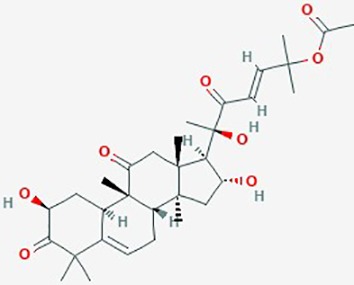
|
Cell cycle; JAK/STAT3 signaling pathways; cytoskeleton | 10-7 M | Cell cycle arrest at G2/M phase; induce apoptosis; disrupt actin and microtubule network; inhibit cell migration & invasion | U87, T98G, U118, U343 and U373 | (Yin et al., 2008) |
| Curcumin (Turmeric) | Curcuma longa (ginger family) | Diferuloyl-methane |
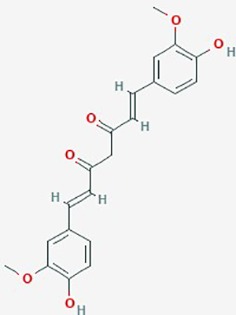
|
AKT/mTOR signaling; angiogenesis, MMP-9 expression |
1. Curcumin (0–250 µg/ml), TMZ (0–250 µg/ml), or combined at (1.25 µg/ml) + (15.6 µg/ml) respectively. 2. Curcumin (0–120 mg/Kg/day) |
1. Combined treatment synergistically increased sensitivity to TMZ; enhanced apoptosis, increased ROS production, disrupted AKT/mTOR signaling pathways 2. Crosses BBB;, decrease activity MMP-9, inhibit glioma angiogenesis; slow tumor growth; increase animal survival |
1. U87MG xenografted mouse models 2. U87MG xenografted into athymic mice |
1. (Yin et al., 2014); 2. (Perry et al., 2010) |
| Dioscin |
Dioscorea nipponica Makino; D. zingiberensis Wright (yam family) |
Saponin |
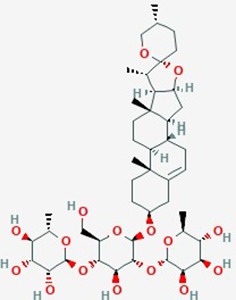
|
ROS, apoptosis, Bcl2, Bcl-xl genes, apoptosis | Dioscin (1.25 – 5 µg/ml) | Increase apoptosis (dose dependent); DNA damage; increase ROS; down regulate expression of Bcl2, Bcl-xl; inhibit proliferation | C6 gloma cells | (Lv et al., 2013) |
| Epigallocate-chin gallate | Camellia sinensis (tea flower) | Polyphenol |
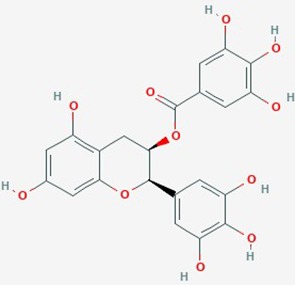
|
1. Matrix metalloproteinases, MMP2; 2. cell viability; apoptosis |
1. EGCG (25 µM) 2. EGCG (12.5, 25, 50 µg/mL) |
1. Inhibit MMP-2 activation; reduce cell viability 2. induce apoptosis; reduce viability |
1. U87 MG; 2. U373 MG; C6 glioma |
1. (Annabi et al., 2002); 2. (Yokoyama et al., 2001) |
| Ginseng | Panax ginseng | Ginsenoside Rg3 |
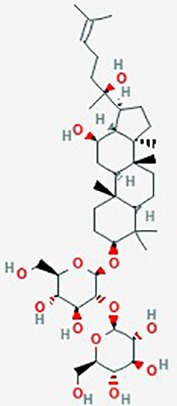
|
VEGF; Bcl-2; apoptosis | Rg3 (0–180 µg/ml), TMZ (0–180 µg/ml) Or Rg3 (10, 80 or -180 µg/ml) + TMZ (10, 80 or 180 µg/ml) |
Downregulate VEGF and Bcl-2, suppress angiogenesis, combined TMZ with ginseng showed additive inhibition of proliferation (time and dose dependent); cell cycle arrest; increased apoptosis; reduced angiogenesis | Rat C6 glioma | (Sun et al., 2016a) |
| Honokiol | Magnolia officinalis (houpu magnolia) | Hydroxylated biphenol |
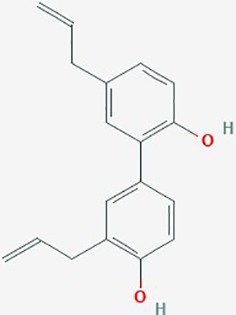
|
1. STAT3 signaling; ERK1/2, Bcl-Xl, autophagy 2. proliferation, angiogenesis 3. Notch signaling, MGMT |
1. Honokiol (6.25–50 µM) 2. Honokiol (0–35 µg/ml) 3. Honokiol (0–5 µM); TMZ (0–500 µM); or combined (10 µM) + TMZ (50µM) |
1. Crosses BBB; increase apoptosis (dose dependent); decrease expression of Bcl-x; increase autophagy 2. inhibit proliferation; increase survival(dose dependent); decrease angiogenesis 3. inhibit proliferation (dose dependent); combined treatment enhanced apoptosis in GBM8401 SP cells; downregulate Notch3 signaling |
1. DBTRG- 05MG 2. U251, rat 9L gliosarcoma xenograft model 3. GBM8401, U87 MG |
1. (Chang et al., 2013); 2. (Wang et al., 2011) 3. (Lai et al., 2015) |
| Icariin (Horny Goat Weed) |
Epimediium species dried leaf (yin yang huo, or horny goat weed) |
Prenylated flavonol glycoside |
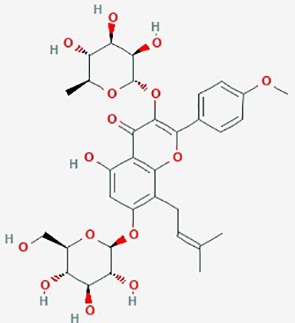
|
NF-κB activity | Icariin (10 µM) + TMZ (200 µM) | inhibit proliferation and apoptosis (dose-dependent); potentiate anti- tumor activity of TMZ; suppress NF-κB activity | U87MG | (Yang et al., 2015) |
| Iridin | Iris versicolor | Glycosyloxyi-soflavone |
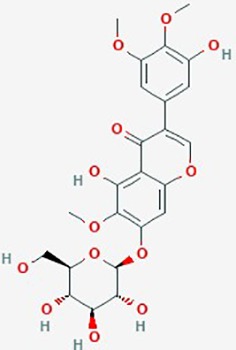
|
Glioblastoma-endothelial interactions | 5 µM | inhibit intracranial tumor growth; increase median survival in xenograft mice; disrupt glioblastoma-endothelial interactions | U87 | (Sengupta et al., 2015) |
| Kalamegha or Kalmega | Andrographis paniculata (AP) | Bicyclic diterpenoid |
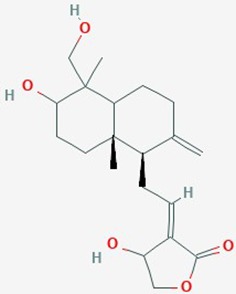
|
Cell cycle; Cdk1 and Cdc25C genes; PI3K/AKT/mTOR signaling pathway | 10–100 µM | inhibit proliferation; inhibit PI3K/AKT/mTOR signaling pathway; decrease expression of Cdk1 and Cdc25C; G2/M cell cycle arrest | U87; U251 | (Li et al., 2012) |
| OLE | Olea europaea (leaf extract) | Phenolic compound Oleorupin |
1. miRNA 2. angiogenesis MMP-2 and MMP-9 3. MGMT methylation, p53 expression |
1.OLE (.005 –2 mg/ml), TMZ (325 or 450 µM) or OLE (1mg/ml) + TMZ (325 µM) 2. OLE (2 mg/ml), bevacizumab (2.5 mg/ml) or combined OLE (2 mg/ml) + bevacizumab (2.5 mg/ml); 3. OLE (1 mg/ml) or in combination with TMZ (350 µM) |
1. Upregulate miRNA-181b, 153, 145, 137 & let-7d expression, increase apoptosis (i2 mg/ml); reduce angiogenesis; increase efficacy of TMZ when combined with OLE 2. reduce expression of VEGF, MMP-2 and 9; reduce tumor weight; reduce invasion and migration; combined treatment synergistically enhanced effect of bevacizumab 3. OLE (1 mg/ml) induced CpG island methylation in MGMT gene, combined with TMZ significantly increased toxicity on MGMT unmethylated cells |
1. T98G 2 T98G and GSC+ cells from 5 GBM patients. 3. Tumor cells from 21 GBM patients |
1. (Tunca et al., 2012); 2. (Tezcan et al., 2017a) 3. (Tezcan et al., 2017b) |
|
| Osthole | Ripe cnidium fruits belonging to Umbelliferae | 7-methoxy-8-isoamyl alkenyl coumarin |
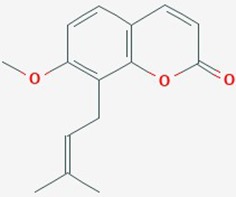
|
miR-16, MMP-9 signaling pathway, proliferation, apoptosis | Osthole (0–200 µM) | Upregulate miR-16; reduce protein expression levels of MMP-9; suppres proliferation; accelerate apoptosis | U87 | (Lin et al., 2015) |
| Paeoniflorin | Radix Paeoniae Alba (Paeonia lactiflora) | Monoterpene glucoside |
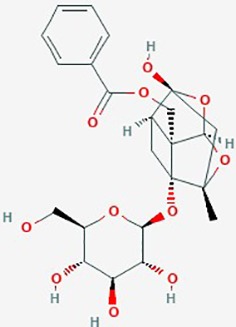
|
1. TLR4, TLAR4/Triad3 A pathway, ubiquitination proteasome pathway (UPP) 2. HGF/c-Met signal, RhoA/ROCK signaling, cytoskeleton 3. apoptosis, STAT3 signaling |
1. Paeoniflorin (0–40 µM) 2. Paeoniflorin (0–40 µM) 3. Paeoniflorin (0–20 mM) 4. Paeoniflorin (0–20 µM) |
1. inhibit cell proliferation (dose dependent); downregulate TLR4; promote TLR4 degradation 2. inhibit HGF induced migration & invasion, actin cytoskeleton organization via c-Met Rho/ROCK signaling; downregulate Rho 3.apoptosis; inhibit proliferation (dose & time dependent); increase miR-16; reduce MMP-9; proteosome degradation of STAT3 and downstream Bcl-2 & Survivin 4. accelerate apoptosis; reduce cell proliferation, increase miR-16, downregulate MMP-9 |
1. U87, U251, U118, T98G and U87 xenograft mouse model 2. T98G; HA1800, HEB 3. U87, U251 4. U87 |
1. (Wang et al., 2018b) 2. (Yu et al., 2019) 3. (Nie et al., 2015) |
| Plumbagin | Roots of Droseraceae, Plumbaginaceae & Ebenceae |
Napthoquinone |
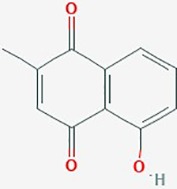
|
Cell cycle, apoptosis | Plumbagin (0–6 µM), KNS60 showed the highest sensitivity at a concentration of 3 µM | DNA damage; cell cycle arrest; apoptosis. Upregulate PTEN, TNFRSF1A; downregulate E2F1; lower MDM2, cyclin B1, survivin and BCL2 protein expression; inhibit telomerase; telomere shortening following chronic treatment |
A172; U251; KNS60; | (Khaw et al., 2015) |
| Quercetin | Broccoli, red onions, apples, red grapes, cherries and berries |
Flavonoid |
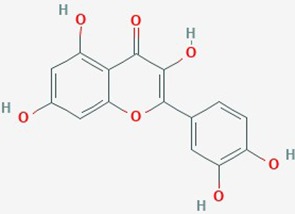
|
1. IL-6, STAT3 signaling, proliferation, apoptosis 2. Hsp27, apoptosis 3. cell cycle, apoptosis |
1. Quercetin (0–50 µM) 2. TMZ (200 & 400 µmol/L) alone or in combination with Quercetin (30 µmol/L); 3. Quercetin (200 µmol/L) |
1.Inhibit IL-6 mediated JAK/STAT3 signaling pathway(dose dependent); reduce proliferation and migration 2.increase sensitivity of GBM lines to TMZ by suppression of heat shock protein 27 (Hsp27) 3. increase caspase-3 & -7 proteolytic activity; induce autophagy (dose dependent); apoptosis |
1. T98G; 2. U87; U251, 3. U373MG |
1. (Michaud-Levesque et al., 2012); 2. (Sang et al., 2014); 3. (Kim et al., 2013) |
| Resveratrol | red wine Vitis, mulberry, peanuts | Polyphenolic phytoalexin |
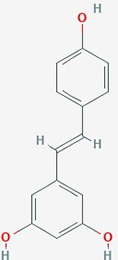
|
1. Notch 1 signaling, AKT; Bax2 expression G2/M cell cycle 2. cell cycle, MMP-9 3. invasion 4. extracellular matrix remodeling proteins, invasion 5. apoptosis, NF-kB 6. MGMT expression, apoptosis 7. apoptosis |
1. Resv (50 or 100 µM) 2. Resv (10 µM), TMZ (100 µM); Resv (10 µM) + TMZ (100 µM) 3. Resv (5–20 µM) 4. Resv (1 or 50 µM) 5. Resv (5 µM) 6. Resv (100 µM), TMZ (100 µM) or combined 7. Resv (20 or 40 µM), TMZ (100–1200 µM) or combined Resv (20 or 40 µM) + TMZ (200 or 400 µM) |
1. Activate Notch-1 expression; induce AKT dephosphorylation; increase Bax and decrease Bcl-2 2.inhibit growth (dose dependent); reverse TMZ resistance by reducing MGMT; increase apoptosis; increase caspase-3 cleavage; G2/M cell cycle arrest; downregulate MMP-9; increase ROS; inhibit mTOR signaling; downregulate Bcl-2 3.reduce TNF-induced invasion; suppress NF-κB activity; downregulate uPA and its receptor 4. decrease MMP-2 expression (dose dependent); decrease SPARC expression 5. block activation of NF-kB (dose and time dependent); 6. reverse TMZ resistance, increase apoptosis, decrease IC50 of TMZ, decrease NF-kB content 7.enhance TMZ induced apoptosis |
1. A172, T98G 2. SHG44, in vivo rat model 3. U373MG 4. T60, T63 5. H4 6. T98G 7. GICs from 2 patients |
1. (Lin et al., 2011); 2. (Yuan et al., 2012); 3. (Ryu et al., 2011) 4. (Gagliano et al., 2005); 5. (Manna et al., 2000) 6. (Huang et al., 2012) 7. (Li et al., 2016a); |
| Rutin (faveira) | Dimorphandra mollis | Flavonoid |
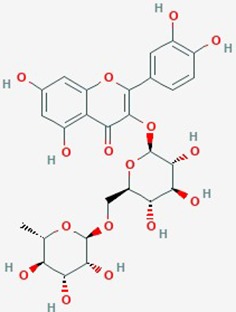
|
VEGF and TGF-β1 | 50 and 100 µM | Reduce levels of VEGF and TGF-β1 (reversed after 72h) | GL-15 | (Freitas et al., 2011) |
| Silvery wormwood | Artemisia argyi (Chinese mugwort) | Trihydroxy-flavone | Cell cycle; apoptosis; Bax and p53 genes |
30–300 µM | inhibit proliferation; promote apoptosis; cell cycle arrest in G2/M phase; increase pro-apoptotic protein Bax and p53 expression |
U87 | (Khan et al., 2012) | |
| Tagitinin C Mexican sunflower |
Tithonia diversifolia | Sesquiterpenoid |
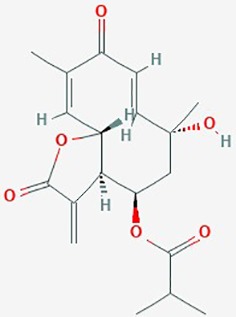
|
Cell cycle, survivin | 0–10 µg/ml | inhibit viability in vitro; autophagic cell death and G2/M arrest | U373 | (Liao et al., 2011) |
| Tetrandrine (Tet) | Stephania tetrandra | Bisbenzyliso-quinoline alkaloid |
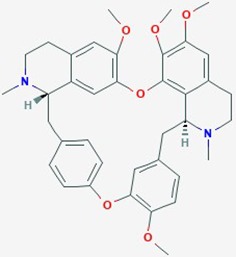
|
Cell cycle; ERK signaling pathway; PCNA and cyclin D1 genes | Tetrandirine (20 umol/L) + radiation (1.21 Gy/min) | inhibit cell proliferation; G0/G1 cell cycle arrest; attenuate radiation-induced ERK signaling; decrease expression of proliferation associated genes PCNA and cyclin D1 |
U87; U251 | (Ma et al., 2017) |
| TQ | Nigella sativa | Thymoquinone | Autophagy, apoptosis | TQ (0–35 µM) | inhibit autophagy; induce cathepsin-mediated cell death | T98G; U87MG | (Racoma et al., 2013) | |
| Withaferin A; Ashwagandha | Withania somnifera | Steroidal lactone |
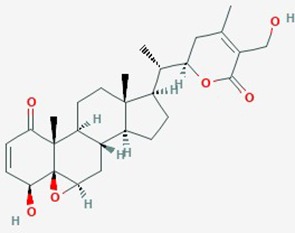
|
1. MGMT expression; Akt/mTOR pathway; cell cycle 2. cell proliferation and migration 3. apoptosis, cell cycle, cyclin D1, bcl-xl, p-Akt genes, NF-Kb, VEGF, HSP 70 |
1. Withaferin A (0.5–2 µM) alone or with TMZ (10–50 µM for sensitive, 100–500 µM for resistant lines) 2. Withaferin (0.1–5 µM) 3. Withania water extract |
1. decrease proliferation; G2/M cell cycle arrest; deplete MGMT; reversed MGMT mediated TMZ-resistance; apoptosis via inhibition of Akt/mTOR pathway; cell cycle arrest 2. inhibit proliferation; delay migration 3. G2/M cell cycle arrest, increase apoptosis; suppress cyclin D1, bcl-xl, p-Akt genes, suppress NF-Kb, VEGF, HSP 70; reduced intracranial tumor volume |
1. U87, U251, T98G, U87 TMZ, U251 TMZ 2. C6 rat glioma, YKG1 3. Rat model of orthotopic glioma allograft |
1. (Grogan et al., 2014) 2. (Shah et al., 2009) 3. (Kataria et al., 2016) |
| Xanthohumol | Hop cones of Humulus lupulus L. | Prenylated phenolic constituents |
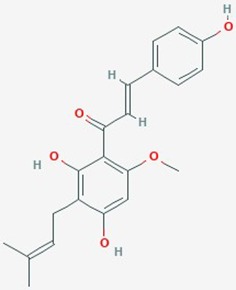
|
Apoptosis Caspase-3, 9 and PARP cleavage; Bcl-2 protein | 20 µM | increase ROS; apoptosis activated by MAPK; down regulate Bcl-2 protein | T98G, U87-MG | (Festa et al., 2011) |
| γ-Mangostin |
Garcinia mangostana |
Xanthone |
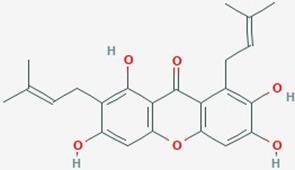
|
Cell cycle; apoptosis | 10–200 µM | inhibited proliferation; increase hypodiploid cells; reduce viability (dose dependent); induce apoptosis; increase ROS production and mitochondrial dysfunction | U87; GBM 8401 | (Chang et al., 2010) |
Yellow highlighted boxes denote compounds with published effects on glioma migration and/or invasion. Chemical structures were downloaded from NINLB PubChem at https://pubchem.ncbi.nlm.nih.gov/
